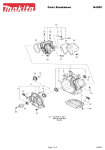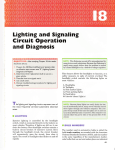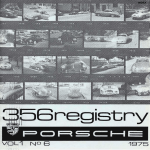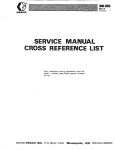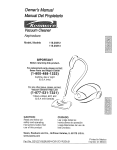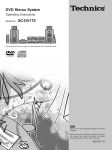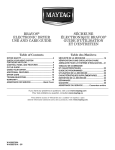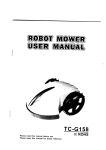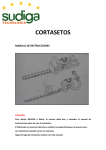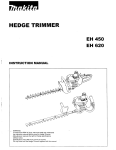Download Makita EH561 Service manual
Transcript
MODEL EH561/EH760 SERVICE MANUAL . 1 SPECIFICATIONS a. Designation of Parts . . . . . . . . . . . . . . . . . . . . . . . . . . . . . . . . . . . . . . . . . . . . . . . . . . . . . b. Specifications ........................................................... 3 4 . 2 PREPARATIONS a. Disassembly & Reassembly Procedure . . . . . . . . . . . . . . . . . . . . . . . . . . . . . . . . . . . . . . 5 b. Cautions 6 .............................................................. . 3 DISASSEMBLY 81ASSEMBLY PROCEDURES ............................... 7. 9 a. Removal of Engine and Machine Body . . . . . . . . . . . . . . . . . . . . . . . . . . . . . . . . . . 10 . 11 b. Disassembly & Assembly of Machine Body . . . . . . . . . . . . . . . . . . . . . . . . . . . . . . 12 . 13 c . Disassembly & Assembly of Engine .................................... 14 . 18 d. Disassembly & Assembly of Carburetor . . . . . . . . . . . . . . . . . . . . . . . . . . . . . . . . . 19 . 24 4 . CHECKUP AND ADJUSTMENT a . Daily Checkup and Adjustment . . . . . . . . . . . . . . . . . . . . . . . . . . . . . . . . . . . . . . . . . . . . 25 b. Checkup and Adjustment for Every 30 - 50 Hours. (Every 10 Days) . . . . . . . . . . . . . . . 26 c. Checkup and Adjustment for Every 100 - 200 Hours. (Monthly) . . . . . . . . . . . . . . . . . . 26 . 5 STANDARD OF ADJUSTMENT a. Tightening Torque of Components . . . . . . . . . . . . . . . . . . . . . . . . . . . . . . . . . . . . . . . . . 27 b. Standard Adjustment Table 28 ............................................... c. Lubrication Procedure . . . . . . . . . . . . . . . . . . . . . . . . . . . . . . . . . . . . . . . . . . . . . . . . . . . d. Bladesharpening . . . . . . . . . . . . . . . . . . . . . . . . . . . . . . . . . . . . . . . . . . . . . . . . . . . . . . . e. BladeAdjustment . . . . . . . . . . . . . . . . . . . . . . . . . . . . . . . . . . . . . . . . . . . . . . . . . . . . . . . 6. TROUBLESHOOTING ................................................. 2 30 28 28 29 - 31 1 SPECIFICATIONS a. Designation of Parts Fiirl lank rap \ I o switrtl (ONorr) b. Specifications I Model EH760 EH561 Dimensions (L x W x H) mm 1,041 x 280 x 258 840 x 246 x 225 Mass (with blade cover) kg 5.8 5.8 Volume (fuel tank) cm3 600 Engine displacement cm3 21.7 Cutting length mm Maximum engine performance kw 735 560 0.74 I Maximum blade speed m/s 1 1.88 1 Idling speed l/min I 2,600 Clutch engagement speed l/min Carburetor type type WALBRO WYL Ignition system type Solid ignition system Spark plug type NGK-BMR7A Electrode gap mm 0.6 - 0.7 3,600 Mixture ratio (fuel: MAKITA 2-stroke oil) 50: 1 Gear ratio 14 : 58 1) The data takes equally into account idling and racing speed operating modes. I 2. PREPARATIONS a. Disassembly and Reassembly Procedures The disassembly and reassembly procedures mentioned below are given as a general rule. These procedures can be added to or omitted according to your operating conditions. II. PREPARATIONS Cleaning Drainage of fuel Disposition of tools I Ill. DISASSEMBLY 1. Machine body 2 Engine Cleaning of parts CHECKUP Checking of parts (Refer to IV. CHECKUP AND ADJUSTMENT) (Refer to V. STANDARD OF ADJUSTMENT) (Refer to X. SETTING OF BRUSH BLADE) 1 1. Engine IV. REASSEMBLY 2 Machine body (Refer to VIII. TABLE OF TIGHTENING TORQUE) I . STARTING TEST c 1. Starting procedure 2 Checkup and adjustment of carburetor Checkup and adjustment I (Refer to IX. TROUBLESHOOTING) NOTE: The numbers are the same as those in this manual. 5 b. Cautions 1) Preparations (1) Workbench (2) Disassembly and reassembly kits and gauges (3) Washing bowl (4) Rinse oil (light oil, gasoline, etc.) (5) Oil (mobile oil), grease (6) Adhesive, sealant (7) File, sandpaper (8) Shop cloth 2) Cautions in Disassembly (1) Use standard tools correctly. (2) Handle disassembled parts with care and be sure to clean them. In particular, remove dust or dirt adhering to the mounting surfaces of packings. Bearings in rod are easy to separate. If there is no abnormality on rod, no special maintenance is needed without removing contaminated grease. (3) Keep disassembled parts in order to avoid loss or error in reassembly. (4) If it is hard to loosen bolts or screws, use an impact driver. 3) Cautions in Reassembly (1) Pay attention to the combination of parts (in particular, mounting direction: front and rear, right and left, upper and lower). (2) Replace packings and gaskets with new ones. (3) Tighten bolts and screws twice in a diagonal manner. (4) Apply two-cycle engine oil (or Mobile oil) to rotary and sliding parts. (5) During reassembly, be careful to keep parts free of dust and dirt. (6) For rotating parts, turn them by hand to check for movement or noise. (7) After reassembly, turn the rotating parts by hand and confirm that there is no abnormality (loosen- ing, etc.) (8) Never fail to apply genuine grease into case. 6 3. DISASSEMBLY & ASSEMBLY PROCEDURES _ / 7 _ - - \ 8 I 9 a. Removal'of Engine and Machine Body For EH561 1. StarVStop lead wire Remove lead wire connecting rear-handle stop switch with engine. 2. Throttle wire Remove cable holder fixed to rear handle by loosening screw (M4 x 10). Remove throttle wire from throttle lever parts. Cable h o l d e r 3. Engine Remove engine by loosening two bolts (M6 x 15, PW, SW) with fixing case and engine and one bolt (M6 x 40, W, SW) with combine rear handle with case and engine. 4. Rear handle Loosen bolt (M6 x 50, W, SW) on case side and remove rear handle. 5. Front handle Loosen bolt (M6 x 35, SW) with fixing case and front handle and remove front handle. 10 For EH760 * 1. StarVStop lead wire Remove lead wire connecting rear-handle stop switch with engine. 2. Throttle wire (For STD) Remove throttle wire form throttle lever. (For CE) Remove throttle wire from carburetor. 3. Left handle Loosening two bolts (M5 x 30)with handle holder. 4. Handle holder Loosen two bolts (M6 x 35, W, SW) with engine. 5. Engine Remove engine by loosening three bolts (M6 x 15, PW, SW) with fixing case and engine. 6. Right handle Loosening two screws with Blade and remove right handle. 11 b. Disassembly 4% Assembly of Machine Body Crank q e a r Drum . \ U p p e r case -Lower ca5 Pinion qear / 1. Drum Lock blade by tightening 3 blade slide screws to the full. Then remove drum by using drum hole. If drum can not be loosened, apply wood chip under blade nearer at engine and remove drum by using drum hole. <Caution> The screws are right-handed. Turn to the left in loosening. Be careful not to miss collar under drum. 2. Lower case Remove 3 blade-fixing U-nuts first. Then loosen 7 bolts (5 M5 x 16 and 2 M5 x 20) and remove lower case. It is advisable to remove lower case, tapping it with plastic hammer. If it is hard to remove case, pry case with flat-headed screwdriver paying attention not to damage case or parts inside case. After mounting, temporality tighten 3 blade-fixing U nuts. (Apply oil to sliding parts in proper amount.) <Caution:, This work must be done at a place as low as possible, as there is possibility that needles separate if rod is detached together with case. Be careful not to damage case contact surfaces. Apply grease to rod and gear in proper amount. 12 3. Rod slide plate, Pinion gear, Felt Loosen 2 screws (M3 x 5) and remove rod slide plate fixed under lower case. Then remove pinion gear from upper case. If it is hard to remove, tap pinion with plastic hammer. Then remove felt. 4. Rod Remove rod on lower-blade side. <Caution> Before removing rod, apply a small amount of grease to needles and turn rod several times so that they will not separate. Keep in memory rod mounting direction. Apply grease to crank and lower-blade rod shift and mount rod. 5. Lower/Upper blade Loosen 3 blade-slide screws and remove lower blade. <Caution> Be careful not to miss blade slide washer. Then remove upper blade. 6. Crank gear, Crank Remove crank gear and crank from upper case. If it is hard to remove, tap case with plastic hammer. Then loosen screws (M5 x 10) fixing crank gear and crank and remove crank. <Caution> Apply grease to upper case in proper amount. Apply grease to crank gear and crank in proper quantity and mount them in upper. 7. Retainer plate, Grease nipple Loosen flange nut and 2 screws (M5 x 16) and remove retainer plate. Then remove grease nipple. c. Disassembly & Assembly of Engine 14 0 V w m Q u -J / / -I 0 t-a Z 0 ,/ i a: 0 t- W a 3 m a cl u 15 1. Fuel tube Pull fuel tube about 20 - 30 mm out side fuel tank for easy assembly. Assemble fuel tube as shown in the figure. Return fuel tube to within the tank following assembly. (with no bends that might prevent smooth fuel flow) 2. Cylinder cover Keep the muffler gasket and insulator gasket in the correct position when assembling the cylinder cover. Insulator Keep the cover spacer and washer in the correct position when assembling the cylinder cover to the cylinder. 3. Buffle plate Assemble buffle plate to blower housing as shown in the figure. 16 4. Clutch Keep the washer in the correct position when assembling the clutch. 5. Ignition coil Use thickness gauge to assure that the air gap will be 0.3 - 0.4 mm between the ignition coil and flywheel magnet portion when installing the ignition coil. 6. Flywheel Install the socket head bolt onto the crankshaft and tighten them securely. Remove the flywheel with a pulling tool as shown in the figure. During assembly, be sure first that you have the crankshaft key slot properly aligned with before installing. Then check the key slot and flywheel alignment indication. 7. Crankcase When assembling the crankcase, cut off the crankcase gasket sticking out from the cylinder installing surface. (See figure at right) cutter blade 8. Cylinder When assembling the cylinder, coat both the cylinder inner surface and the piston itself with 2-cycle engine oil. 17 9. Piston When equipping the piston in the crankshaft ass’y, the triangular mark ( A ) on the top of the position should be on the crankshaft key slot side. 10. Piston ring When installing the piston ring on the position, align the knock pin on the piston with the split on the piston ring. Unless they are lined up the cylinder cannot be assembled. 18 d. Disassembly & Assembly of Carburetor 1) Function of Parts 19 (1) Throttle Valve Controls engine output. (2) Tamper Resistant Plug: Prevents entry of air and foreign matter. (3) Low-Speed Needle: Regulates fuel at idling or slow rpm. (4) Inlet Screen: Filters fuel intake to carburetor. (5) Needle Valve: Controls fuel supply to metering chamber from fuel pump. (6) Fuel Inlet: For fuel intake. (7) Metering Lever Spring: Works together with metering diaphragm to ensure constant pressure in metering chamber. (8) Metering Lever: Conveys operation of metering diaphragm to needle valve. (9) Metering Diaphragm: Works up or down depending on difference of pressure inside engine and atmospheric pressure so as to open or close the needle valve through the metering lever and metering spring. (10) Metering Chamber: Supplies fuel via nozzle by fuel tank. (11) Fuel Pump Diaphragm: Undulates, in keeping with engine pulse. This action serves to send fuel to the diaphragm chamber. (12) Fuel Outlet: Allows excess fuel to return to the tank during primer pump operation. (13) Engine Pulse: Takes the negative or positive pressure building up in the crankcase under piston operation and makes the fuel pump diaphragm work accordingly. (14) Main Jet: Regulates fuel at high speed. (15) Nozzle: Outlet for fuel sent into the cylinder. (16) Idle Adjust Screw: Controls idling rpm. (17) Primer Pump: Brings fuel up from the fuel tank into the metering chamber. (18) Combination Valve: Acts as a check valve between primer pump intake and charge. (19) Main Check Valve: Prevents air in the nozzle from entering the metering chamber when the primer pump is being worked. (20) Outlet Valve: Works just the opposite of the inlet valve. (21) Inlet Valve: Valve opens when diaphragm is subjected to negative pressure, and closes under positive pressure, corresponding to the pump action. 20 2) Maintenance PI11MLlI PIIMP -I’I1IMLTl I’UMP W L I I - - 21 A) DISASSEMBLY AND ASSEMBLY PROCEDURE 1) Refer to the disassembly drawing when disassembling or assembling. 2) Be careful not to damage gaskets and the like when assembling 3) Do not attempt to disassemble the throttle valve ass’y or pump body ass’y. 4) When you find during disassembly of the carburetor that the inlet screen is clogged or there is considerable dirt buildup in the carburetor itself, be sure to clean out the fuel tank and replace the fuel tank filter. B) INSPECTION PROCEDURE 1) Clean off the tool body and dry off with an air nozzle. 2) Check for dirt adhering to the main jet or corrosion. Blow off any dirt with an air nozzle. 3) Be sure gaskets and the like are not damaged or deformed. Replace as necessary. 4) Check for damage or hardening of the pump diaphragm. Be sure inlet and outlet valves are horizontal and not bent. 5) Check for possible damage or hardening of the metering diaphragm. The plate should not be sent. 6) Check for bending or damage to the pump plate. 7) After cleaning the pump body ass’y, check spring deformation, lever height, inlet screen (for dirt clogging it), valve operation, etc. When inspecting check valve operation, look for blockage due to dirt at the check valve portion or vinyl pipe by blowing through the port. If blocked, replace. CAUTION: Never blow air into the check valve under high pressure. 8) Check for possible deformation of the air purge body, combination valve, etc. 9) Lock for holes, damage or hardening of the primer pump. 22 3) Adjustment of Carburetor (1) Idle adjusting screw The standard idling rotational speed is 2,500 - 2,700 rpm. Adjust the speed as high as possible so that the blade does not turn. Right : for higher speed (rpm) Left : for lower speed (rpm) (2) Metering lever The metering lever is a very important part. Never tamper with it under normal conditions. Measure as shown below, when checking the height of the metering lever or when measurement is necessary. Standard height: 1.5 0.15 mm * The fuel is rich when the end of the control lever goes up as shown in the solid line in the drawing, and is lean when the dotted line goes down in the direction of the arrow. * (0.059 0.006") carburetor body (3) Main jet When replacing the main jet, always use one with the same number. 23 4) Troubleshooting METERING SYSTEM Inlet Needle 8 Seat I O I Foreian matter Io I Wom inlet needle valve I Inlet needle valve stuck I Metering Diaphragm I0 I Io I I 0I 0I Diaphragm damage Loose screw on diaDhraam cover Gasket defect I I I Button damage Metering Lever Spring BEl 0 Improper installation 000 Lever set too low Lever set too high 0 0 0 0 Leverdamage CIRCULATION SYSTEM Loose carburetor Io I 00 0 0 0 0 Manifold gasket failure 0 Check valve failure (foreign matter) I 0I PumD diaDhraam failure 1 I Pump cover screw(s) loose 0 Io I Pulse leakage I Fuel Tank 8 Pumo Io I I 0I 0 0 0 Wrong fuel Air leak in fuel Dassaaes Fuel passages blocked Tank filter jammed Air vent holes clogged (tank cap) IUSTMENT Idle adjust screw I I 4. CHECKUP AND ADJUSTMENT a. Daily Checkup and Adjustment 1. Aspect Confirm that there is no damage or wear. 2. Bolts, nuts, damper pin Check bolts and nuts for damage, wear or tightening. Retighten if necessary. 3. Safety cover Check safety cover for damage or loosening. Confirm that the safety cover is mounted in contact with gearcase. 4. Trimmer blade Confirm that Trimmer blade is set correctly. Checkup Trimmer blade for chipping, crack or bend. Replace if necessary. 5. Handle Confirm that handle-fixing bolt is fastened securely. 6. Cleaning of dirt, dust or saw dust 1) Crankcase If there is any dust or dirt adhering to cooling air inlet, fan cover-cylinder fins, etc. of rear crankcase, disassemble them and remove dust or dirt. 2) Cylinder If there is any dust or dirt adhering to cylinder fin, detach cylinder cover and remove it. 7. Throttle lever Confirm that throttle lever can be operated smoothly. Can engine be operated from low speed to high speed? 8 . Stop button Confirm that stop button can be operated smoothly. Can engine be stopped without fail? 9. Muffler, Muffler cover Check muffler and muffler cover for damage or loosening. Remove carbon in muffler if present. 10. Operating and rotating parts Check operating parts for abnormality and rotating parts for abnormal noise. 25 b. Checkup and Adjustment for Every 30 - 50 Hours (Every 10 Days) 1. Air cleaner Remove cover of air cleaner and cleaner filter inside with gasoline. After wringing, fit it to air cleaner. 2. Spark plug If spark plug is damaged or becomes dirty, clean it well with gasoline or sand it with sandpaper so as to adjust spark gap to 0.6 - 0.7 mm. 0.6- 0.7 mm (0.024- 0.028”) c. Checkup and Adjustment for Every 100 - 200 Hours (Monthly) 1. Cleaning and adjustment of carburetor Clean diaphragm, throttle, etc. of carburetor with gasoline. Refer to description on idling adjustment and fuel adjustment. 2. Fuel tank filter Clean dust or dirt inside fuel tank with gasoline. Clean tank inside. Replace filter if filter screen inside felt is clogged. 3. Muffler Remove muffler. Remove carbon adhering to muffler, cylinder exhaust port and tail pipe. 4. Clutch shoe Remove clutch bolt and detach clutch shoe from holder. Apply grease to inside of shoe-mounting hole and clutch bolt and mount them. 5. Replacement 1) Replace cleaner element. 2) Replace spark plug. 26 4. STANDARD ADJUSTMENT a. Tightening Torque of Components Main Body 1 1 Tightening Part I Tightening Torque (kg. cm) Grease nipple 35 f 5 Retainer plate 40 !z 50 *5 I Screw (Diam. x Length) Remarks * Screw M 5 x 16 Flange nut M5 Screw I Crankgear I 50 f 5 I M5x 10 I Screw I Rod slide plate I 15f3 I M3 x 15 I screw I Lowercase I 45 I M5x16,M5x20 I Screw 5 Blade fixing U nut 8 0 i 10 Drum 170 Front case 50 f 5 Upper case I I f Cable holder Rear handle main unit I I I I * 20 M6 U nut M10 - M6 x 30 I I I I 75 f 5 50 f 5 8-13 8 - 13 M6x15 M6 x 40 M 4 x 10 M4x16,M4x30 Bolt I I 1 I Bolt Bolt Screw Screw Use quick-set bonding adhesive. Engine Tightening Torque (kg ' cm) Tightening Part Screw (Diam. x Length) Remarks Crankcase 45 f 5 M5 x 25 Screw Cylinder 80f 10 M5 x 20 Socket head bolt Flywheel 100 f 10 M6 x 16 Bolt Ignition coil 25 f 5 M4 x 20 Screw Spark plug 150 f 3 M14 75 i5 M5 x 50 45 f 5 M5 x 25 Screw Carburetor 25 f 5 M5 x 65 Screw Blower housing 45 f 5 M5 x 16 Screw Recoil starter 15 - 20 M5 x 14 Screw (Black) Cylinder cover 30 f 5 M5 x 14 Screw (Black) Muffler cover 40 f 5 M 5 x 16 Screw Tank plate 45 5 M 5x 16 Screw Fuel tank 45 f 5 M5 x 16 Screw Muffler Insulator f NGK-BMR7A * Socket head bolt I Clutch I 90f 10 I M6 x 25 I Bolt I Holder I 7 5 f 10 I M6 x 14 I Bolt Use quick-set bonding adhesive. 27 b. Standard Adjustment Table I Test Parts I I Air gap Spark plug electrodes gap I I I Standard Size (mm) 0.3 - 0.4 0.6 - 0.7 I I I c. Lubrication Procedure 1) Oil Mobile Oil No. 30. ...................... .Throttle wire 2) Grease Shell Albania No. 3 ....................... .Gear case <CAUTION> Always use above oiVgrease or a comparable product. d. Blade sharpening If the edges are rounded and do not cut well any more, find off only the shaded portions. Do not find the contact surface (sliding surfaces) of the top and bottom edges. Before grinding, be sure to secure the blade firmly and switch off the engine and remove the spark plug cap. Wear gloves, protective glasses, etc. An edges ground too much at a time or ground many times will lose its hardened layer. It becomes rounded and dull very quickly in use. \ the rounded tip. 28 I e. Blade Adjustment The blades will wear with long use. When you find that trimming is not as good as when the blades were new, adjust them as follows. 1. Turn Hexagonal U nut loose. 2. Truss screw in with the driver lightly till it stops turning, and then screw it back one quarter to a half turn. 3.Turn Hexagonal U nut tight, holding Truss screw at the same time with a driver. 4. Lubricate the blades after adjustments above with light oil. 5. Start the engine and operate the engine throttle on and off for a minutes. 6. Stop the engine and touch the blades with your hand. If they are warm enough for you to keep your hand on, then you have made the proper adjustment. If they are too hot for you to keep touching, give Truss screw, a little more turnback and repeat 5 to see if the are properly adjusted. <NOTE> Never fail to stop the engine before making the adjustment. The blades have a slot around Truss screw. In case you find dust in the end of the slots, clean it. 0 Hexagonal U nut Trussscrew @ Flat washer @ Blunt extension 0 Blade guide @ Upper Blade 0 Lower blade 29 6. TROUBLESHOOTING Y C 2 V e -- c Abnormality inside engine . . . Check 0) .-c c ln a 0 Malfunction of carburetor . . . . Check 0a.0 % .G a). U a C .cn c a v W with coil . I - 0-0 .cL b c v Defective coil ~ a2 2; . . . . . . . . . . . . .Replace - Stop switch is grounded . . . . . Replace ~ - Defective wiring . . . . . . . . . . . Correct 5+g 2% ......... r Defective or damaged spark plug . . - . . . . . . . . . . . . . . . Replace t -maP c m Incorrect spark plug gap . . . . Adjust Adherence of carbon . . . . . . . Clean with brush -E Spark plug too damp . . . . . . .Dry I Incorrect connection of spark plug gap . . . . . . . . . . . .Correct Felt is clogged with dust . . . . . Replace - Fuel does not Air orifice of tank cap isclogged . . . . . . . . . . . . . . . . Clean keep running Fuel passage in carburetor is clogged with dust . . . . . . . .Clean IDefective -acceleration function Leakage from mounting surface of carburetor . . . . . . . Retighten Air orifice of fuel tank cap is clogged . . . . . . . . . . . . . . . .Clean L---.- -a Pressure leaks . . . . . . . . . . . . Stop leakage (packing, etc.) 3 . I - Clogged needle valve at fuel inlet . . . . . . . . . . . . . . .Clean -Overflow Adjusted metering lever . . . . . Correct Fuel different from specified one . . . . . . . . . . . . . Replace Incorrect opening of throttle lever and choke lever .................... Fuel too lean or rich Operate regularly . . . . . . . . Adjust Fuel overflows into . . . . . . . . Clear needle muffler valve of dust and start with throttle lever fully opened cn .-C !f C L -I 28 z" Tank, felt clogged . . . . . . . . . . Replace Fuel pipe clogged . . . . . . . . . . Clean Air mixed in fuel pipe . . . . . . . Drain air No fuel in tank 30 , - Inadequatefuel used . . . . . . . . . . . . . . . . . . Use specified fuel - Defective plug (overheated) . . . . . . . . . . . . Replace - -Overheated engine Air ventilation hamperedbecause of cylinder clogged with dust . . . . . . . . . . . . Clean (Inlet of cooling air, fan cover, fan, cylinder fin) - Carbon adhering to combustion chamber . . . . . . . . . . . . . . . . . . . . . . . . . . . . Overhaul, clean - Fuel is too lean . . . . . . . . . . . . . . . . . . . . . . Overhaul, clean - Too much load to cutter blade . . . . . . . . . . . Lessen load Damaged or fouled spark plug or inadequatespark gap . . . . . . . . . . . . . . . Replace, clean, adjust Defective -ignition function Irregular adjustmentof low-speed fuel adjusting screws . . . . . . . . . . . . . . . . . Adjust Clean -Defective Carburetor Overflow . . . . . . . . . . . . . . . . . . . . . . . . . . . Refer to indication in previous page. Fouled air cleaner . . . . . . . . . . . . . . . . . . . . Clean Damaged diaphragm membrane . . . . . . . . . Replace Engine runs but__ Poor RPM’s r -Other causes -Blade does not cut well Ineffective compression . . . . . . . . . . . . . . . . Overhaul, check and replace (mis-contact and wear of piston ring) (gas leakage from cylinder and crankcase) (Insufficienttightening of spark plug) . . . . . . Retighten Exhaust port clogged with carbon . . . . . . . . Clean Throffle valve not fully opened . . . . . . . . . . . Open fully Clogged tank filter . . . . . . . . . . . . . . . . . . . . Replace Polished cutter blade . . . . . . . . . . . . . Polish correctly I Slippage of cutter blade . . . . . . . . . . . . . . . . Tighten correctly -Blade fluctuates ____- c Worn or damage rod shaft hole . . . . . . . . . . Replace Worn blade-fixing screw . . . . . . . . . . . . . . . Replace Ft Excessive load on cutter blade . . . . . . . . . . Lessen load Worn clutch shoe . . . . . . . . . . . . . . . . . . . . . -Blade stops ___ Overhaul, replace Excessive tightened blade fixing screw . . . . Mount correctly Damaged small gear or crankgear . . . . . . . Replace Damage centrifugal clutch . . . . . . . . . . . . . . Replace i Damage drum . . . . . . . . . . . . . . . . . . . . . . . -Blade cannot be actuated Replace Damage small gear on crankgear . . . . . . . . Replace Damaged blade rod shaft 31 . . . . . . . . . . . . . . Replace
































